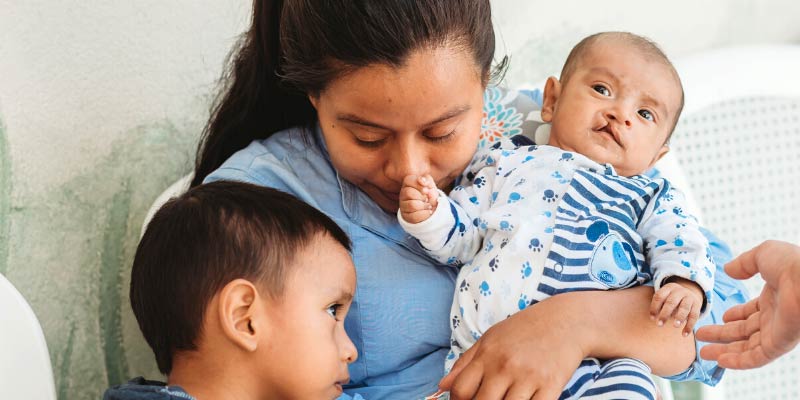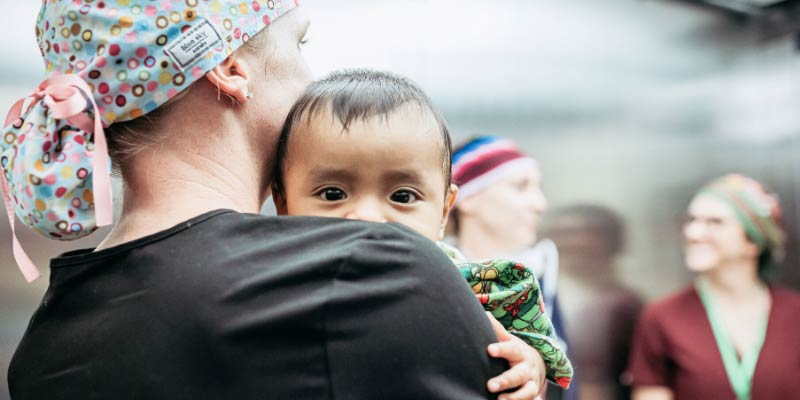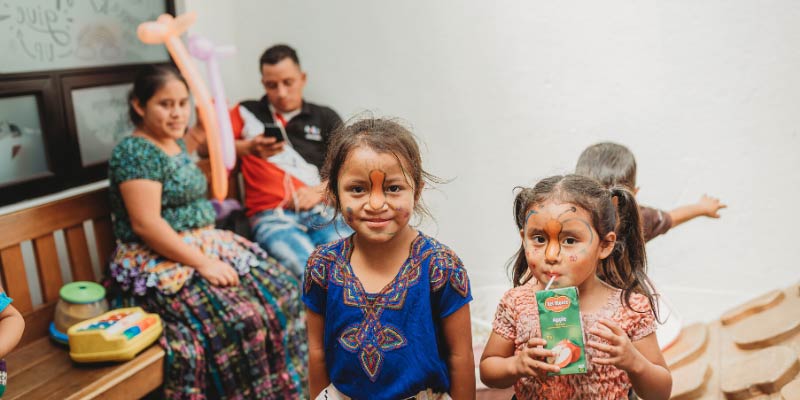by John Paschal
It is 7:30 a.m. on Wednesday, and the sun has risen on the overnight rooms at Hospital Militar Central.
In Habitacion 7-8, nine-month-old Karina Vasquez Perez is crying in the arms of her mother, Reyna, as soft white sunlight filters through a window covered loosely by a thin green drape. Karina’s crying might strike an observer as irony. Just four days ago, Karina played cheerfully in the arms of her mother as they waited in the crowded hallway during triage, her cleft lip no hindrance to her happy smile.
Now, having undergone lip surgery, Karina is sending incongruous tears down a reconfigured face. Indeed, all that remains of the cleft so conspicuous on Sunday is the neat vertical line so discernible in 7:30 sunlight.
Of course, Karina can be forgiven her outburst. She can’t yet see, and is too young to understand, what any observer can clearly perceive: The girl has a whole new look this morning.
Though among the youngest, Karina is just one of the roughly two dozen patients to have undergone procedures during the first two surgical days of the Austin Smiles mission in the capital of El Salvador. With parents or guardians, children have traveled from throughout the Central American country of 6.4 million people to seek medical help at Hospital Militar Central, where the mission has its base of operations.
For reasons that remain uncertain, children in Latin American countries like El Salvador have a one in seven chance of being born with a cleft lip or cleft palate. To help address that need, Austin Smiles has treated more than 18,000 patients and performed more than 7,000 surgeries in its 31 years.
Now, the nonprofit can add one more to the count in the form of Karina Vasquez Perez, and another in the form of Lisbeth Molina Marques. At 7:35 a.m., she is lying in her bed in Habitacion 9-10 and visiting with Dr. Mahlon Kerr. Yesterday, Dr. Kerr joined Dr. Cameron Craven to perform a rhinoplasty on the 15-year-old.
Hers was no Hollywood surgery. She needed surgery to breathe through her nose.
Dr. Kerr is now asking Lisbeth for a selfie.
Side by side, they smile for the camera.
“Gracias,” says Lisbeth.
“De nada,” he replies.
But it’s not nada. It’s not nothing at all.
***
The time is 8:42, and inside OR 1, 11-month-old Uriel Alexander Hernandez is lying atop the table in a dark green surgery gown just small enough to fit his 13.2-lb. body. While anesthesiologist Dr. John Hatridge administers sedation, scrub tech Norma Canchola inspects the surgical table topped with instruments. At the same time, RN Ashley Kerr double-checks the details on Uriel’s surgery chart, which lies at the foot of his bed.
Atop the chart is a close-up photo of the patient’s face. In colorful detail, it reveals a massive bilateral cleft in his upper lip. The anomaly is punctuated by a huge protrusion — a prolabium, in medical parlance — on the right side of the cleft. No amount of well-wishing would make it disappear.
And so, the surgery begins.
“All right!” announces Dr. John McFate as he takes his position at the head of the bed, “a double cleft lip — two-for-one!”
The room is cool and brightly lit. The walls are painted white. Across its space is a loose filigree of electrical cords. Joe Walsh’s “Rocky Mountain Way” is blaring across the speakers. From the anesthesia machine, a series of beeps, dings and hisses is coursing through the air. The anesthesia is as symbolic as it is utilitarian: If all goes as planned, this marks the last time that Uriel has gone to sleep with a cleft. He will never wake as he was.
First, however, the team must do the work.
At 8:44, the first instrument makes touchdown on a tiny area bathed in light. Minutes before the procedure began, Dr. Ned Snyder told the man with the pocket notebook that surgery on children, especially infants, is more difficult than surgery on adults. The reason is obvious: The target is smaller.
“That makes it all the more challenging,” he said.
Now, Dr. Snyder is standing at the right side of Uriel’s bed, just inches from his surgical partner. Wearing surgical loupes over their eyes to more clearly see the detail, the two men begin working in tandem, their four hands dancing above one misshapen lip. The movements are minimal, the fingers patient. Through the thin blue fabric of their surgical masks they discuss the strategy of their approach. Their words are indiscernible to anyone but themselves, their voices low and concealed by the masks.
Meanwhile, as the boy lies motionless, an observer can see the vulnerability of a patient so small. It seems the highest form of trust, a faith enacted between a family in need and the people who came to provide it. He sees a tiny life entrusted to masked strangers who speak a weird language and listen to classic rock. They are aliens who four days ago were on an inbound United jet.
Minutes have passed. Songs have gone by. Apparently, you can track a procedure’s progress by its classic-rock playlist: Bob Dylan. Bob Seger. The Eagles. Led Zeppelin. Still, the surgery is not close to completion. This is no drive-thru surgery. The team is using existing material and breaking it down to something different.
Holding gauze in one hand and a scalpel in the other, Dr. McFate dabs the blood that his right hand coaxes. Next, the surgeons slice deeper into tissue. The lip does not give up easily. Dr. McFate is using considerable pressure to bend the tissue to his will.
An observer might think of surgery as an exercise in delicacy. Now, half an hour in, he might see it as an exercise in exercise. It is physical. To stand in one place is to suffer. To bend the neck downward, without a break, is to dream of massage. The hands almost never stop moving.
In time the lip gives in, grudgingly. The prolabium is more spread out.
As Springsteen sings, “Baby, we were born to run,” Uriel is moving along.
***
The time is 9:45, and Dr. Syboney Zapata is starting a bilateral myringotomy and tympanostomy tube placement in OR 2. The thing to know about a myringotomy and tympanostomy tube placement is that the procedures themselves, in a manner of speaking, are smaller than the words that describe them.
Compared to the relatively molecular realm of plastic surgery, they exist on a quantum scale.
In a myringotomy, the surgeon makes a tiny incision in the eardrum to relieve pressure caused by an excessive buildup of fluid, or to drain pus from the middle ear. The next part of the procedure — the tympanostomy tube placement — comes when the surgeon inserts a tiny tube into the eardrum to keep the middle ear aerated for a prolonged period to prevent the re-accumulation of fluid. To make all this happen, the surgeon gazes through a surgical microscope while using a series of Lilliputian instruments. It’s like putting a tiny ship in a tiny bottle. And that tiny bottle is attached to the side of a little kid’s head.
Seated on a stool, Dr. Zapata is peering at a 10x-magnified image of Elvis Amas Sanchez’s right ear canal. Amid the beeps and dings of the OR, she begins the procedure by scooping out a large accumulation of earwax. Next, using the tiniest of instruments, she makes a Honey I Shrunk the Kids-style slice in the eardrum. The movements are so minimal as to scarcely qualify as movements. She is practically motionless, so still that she might be mistaken for a mannequin.
Next, she administers a long tube and suctions out the …
“Ear boogers,” she says.
Upon removing the gunk, the surgeon maneuvers the tiny tube through the ear canal. The thing is just 1.5 millimeters in height.
Lastly, and in the softest of landings, she positions the tube in the center of the eardrum.
Upon completion, she moves to the other ear to do it again. They call it a bilateral for a reason.
Upon exiting the OR, the steady-handed surgeon confirms a suspicion: She drinks decaf.
***
It is 10:51 in OR 1, and Dr. McFate is suturing what can now be properly called a lip.
True, Uriel’s lip is puffy and distended. It has a line of dark thread in it. But it’s a lip.
“Muy guapo!” says Dr. McFate – very handsome!
Later, Dr. McFate explains the procedure. In a case like this, he says, there’s not as much tissue to use because the cleft is so big. Still, the surgeons must connect the muscle on each side of the cleft to make it whole.
“The muscle has to come together or it will fail,” the doctor says. “It’s a physical puzzle.”
With a pen, he draws a sketch: split this piece here, pull that piece there.
“So, you’ve got to make those pieces fit. You have to put them together.”
***
“That big gap in the middle,” the man says, “is what they’re gonna repair.”
The man doing the talking is anesthesiologist Dr. Keller Matthews, and the man to whom he is talking is the man with the pocket notebook. Having escorted that man to the edge of the surgery bed, Dr. Matthews is directing his attention toward the massive gap in the palate of 22-month-old Genisi Zepeda Zapada.
He sees a canyon of darkness where there should be a ceiling of pink.
The surgery to repair the girl’s cleft palate and bifid (or split) uvula has begun. Seated behind Genisi’s head is Dr. Mahlon Kerr. Standing to Dr. Kerr’s right is Dr. Cameron Craven. With a headlight and surgical loupes, Dr. Kerr peers into a mouth propped open by shiny metal retractors. With a syringe, he begins injecting a local anesthetic into the palate and uvula both to expand the tissue and reduce bleeding.
To describe the intricacies of surgery is to administer the anesthesia oneself. It is to make a reader’s eyes glaze over and close. Suffice it to say, in synopsis, that it is neither conveyed nor grasped easily by anyone who hasn’t completed med school.
What is quickly clear to the layman, though, is the merger of strength and finesse. During a procedure like this one — on soft tissue and hard palate alike — the two must meet in the middle to become a cooperative pair. They must join above the big dark canyon and draw its edges together to turn them into a piece. Symmetry bears as much upon the process as upon the goal by making a demand of ambidexterity. Both hands work in concert, each with an instrument. In this case, as in others, four hands work in concert.
At 12:08, Dr. Kerr begins suturing. The pieces have come together.
Some 70 minutes after the surgery began, he ties the final suture. It is done.
***
Day 3 of surgery has moved into its midday hours. Between cases, team members have stepped into the break room for snacks and drinks. If their timing was right, they nabbed a Salvadoran quesadilla. Meanwhile, the interplay of the mission has continued apace. Overlapped surgeries have kept volunteers Mary Jane Parker and Gloria Matthews busy sterilizing instruments. Meanwhile, logistics guru Willis Skinner has kept the whole thing humming by doing whatever needs doing.
In the triage room, volunteers have handled any number of tasks. In the adjacent wing, physician assistant Margie Bivens and RNs Jan Johnson and Gaby Martinez have tended to patients in the overnight rooms. Meanwhile, the mission dentist, Dr. Tom Sentz, and orthodontist, Lindsay Schuster, have seen every tooth to come their way. In hallways and patient rooms, mother-daughter translators Maria Montero and Consuelo Ugarte have flattened the language barrier. In the recovery room, the RNs have soothed every child.
Through it all, administrators Leilani Briseno, Teresa Cox and Martha Mashburn have kept the gears turning in ways that most volunteers don’t see. The work in the trenches allows the rest to go on.
Now, at 12:15, Dr. Sean Hill is eating a snack in the break room following a two-piece LeFort 1 osteotomy and grafting procedure. He is asked, “What’s up next?”
“A bone graft,” he says. “It’s not exciting.”
“We’ll see about that,” comes the reply.
Minutes later, in OR 3, Dr. Ray Harshbarger is explaining how he and his team will perform the graft procedure on 13-year-old Jose Flores Carbajal. Notwithstanding Dr. Hill’s disclaimer, Dr. Harshbargar sounds excited about the case and the process itself.
Simply put, the team will harvest bone marrow from the boy’s right hip and implant it in his maxilla.
“Bone marrow has cells that will create bone,” the surgeon says. “If we use only bone, it will die. It will fail. Here, the space is small enough that you can pack the marrow in there and it will fuse and grow. Right now, the tooth is erupting in space. The timing of this operation is that we are trying to save the tooth.”
In short order, the sounds of the OR have filled the room — the beeps, dings and hisses.
“All right,” says Dr. Harshbarger. “Let’s do it.”
On the surface, the surgery would seem a zero-sum move — this shifting of stuff from one body part to another. But this is not surface-level stuff. The addition exceeds the subtraction in value.
As Dr. Harshbarger addresses the oral cavity, Dr. Hill begins cutting into the hip. It’s like two radically different surgeries taking place on the same patient. Dr. Hill digs hard while his partner, up top, goes gingerly into the mouth. Soon come the sounds of hammering and chiseling, of harvesting marrow. It’s intense. Dr. Hill is maneuvering his body and changing his footwork, pushing his weight into the blows. He looks like a Greco-Roman wrestler. Next, he begins placing the soft red marrow in a plastic cup.
Meanwhile, up top, Dr. Harshbarger continues the delicate task of prepping the space for the marrow.
It is 1:05 p.m when Dr. Harshbarger summons the man with the pocket notebook. Hesitantly, that man presses forward to face his greatest fear. He gazes into the mouth: blood, teeth, the stuff of bad dreams. Almost immediately, the man gazes at that notebook as a way to avoid passing out on the patient.
Stepping back, he whispers to RN Lya Lacaya, “That was the longest 12 seconds of my life.”
The man with the pocket notebook says he is glad somebody else became the surgeon.
***
Late in the afternoon, the man with the pocket notebook visits the overnight rooms where his morning began.
He steps into Habitacion 7-8. Outside its window, the volcano looms.
Across the room, eight-month-old Josue Rivas Aguillon is in the arms of his dad, Flavio Rivas Garcia.
Freshly off a lip repair, Josue smiles and waves his tiny right hand when he sees the stranger.
“Muy guapo,” says the stranger as he looks at Josue.
“Si,” says his father, smiling. “Muy guapo.”



